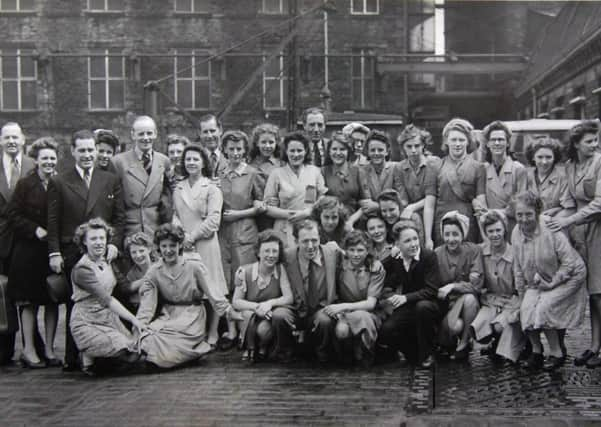The Nostalgia column with Margaret Watson: Looking at the history of Wormalds and Walker’s mill


Some years ago, I read a fascinating little booklet produced by the John Wheelwright Archaeological Society about the history of Dewsbury’s first mill – Low Mill in Thornhill Lees.
This medieval mill, situated on the banks of the Calder, was a predecessor of Wormalds and Walker’s in Thornhill Lees, one of the largest blanket manufacturers in the world.
Advertisement
Hide AdAdvertisement
Hide AdNot only did this Dewsbury archaeological society research the written history of the mill, but also excavated the ground upon which it was built.


Their 44-page booklet was published some years ago, and I’m not sure if it is still available, or if the society is still in existence, but I’m sure there will be a copy available at Dewsbury Library.
The book provides an outline history of the mill from medieval times right up to the late 19th Century, and it also shows photographs of surviving timbers dating back more than 500 years.
I wonder how much of Dewsbury’s history still lies underground because the powers that be did not take such a great interest in the town’s archaeological history.
Advertisement
Hide AdAdvertisement
Hide AdLow Mill, which was known also as Lower or Nether Mill, was water-powered and used for the grinding of corn and the fulling of cloth, long before the start of the Industrial Revolution in the 1800s
All that remained of Low Mill when the dig was started were the stone-lined water channels, a partly-filled artificial water channel and an overgrown pond.
Dewsbury at the time the mill was working was mainly rural, the River Calder ran crystal clear, and the word “mill” didn’t refer to a building, but to the water wheel itself and the millstones which were used solely to grind corn.
This particular mill was in a lovely spot surrounded by fine meadows, and nearby ran the river which provided the water needed to turn its ponderous wheel.
Advertisement
Hide AdAdvertisement
Hide AdAll this land was owned by the lord of the manor, as were all the mills, ponds and dams built upon it.
Agricultural tenants used to take their corn to be ground at the mill, but first they had to agree to give the miller a proportion of the flour his mill would be grinding for them.
And, the miller, in turn had to pay a substantial rent to the lord of the manor, for the privilege of being allowed to us his mill.
Anyone caught grinding corn at home in hand-mills, or having their corn ground in powered water-mills belonging to another lord, would be brought before the manor court and punished.
Advertisement
Hide AdAdvertisement
Hide AdThe book, which gives a full history of Low Mill, shows maps by the great Elizabethan surveyor and cartographer Christopher Saxton, who was born in Dewsbury parish in the 1540s.
When Low Mill was in operation, the Minster church in Dewsbury was the hub of an enormous parish extending from Wakefield in the east to the Lancashire border in the west.
And, as late as the mid-14th Century, the rectory manor was still receiving tithes of corn from numerous townships along the Calder valley and beyond, as well as from Dewsbury itself.
Legal documents researched by the John Wheelwright Archaeological Society, reveal fascinating information about the families who owned the mill and the tenants who rented it.
Advertisement
Hide AdAdvertisement
Hide AdBeing so near the river, both owners and tenants had to repeatedly contend with floods when the Calder burst its banks, as it did regularly, causing financial ruin to some.
Rectory manor financial accounts reveal that the Black Death hit Dewsbury in 1348, causing a reduction in the rent of the mill because there was so much devastation around.
The mill eventually became known as the Dewsbury Mill, and for most of the 17th Century, the tenants were a family named Webster who paid an annual rent of £100, and for most of the 1700s it was owned by a family called Greenwood.
In 1811, John Hague, of Crow Nest, bought the mill and all the associated properties for £33,750, including five mills used for grinding corn and grain, the chipping and grinding of wood, and the fulling of cloth and scribbling, carding, slubbing and spinning of wool.
Advertisement
Hide AdAdvertisement
Hide AdAt the same time he formed a partnership, known as Hague and Cook, with his son, and also his nephew Thomas Cook.
Other partners, Percival and Frank Wormald, distant relatives, were later to join them, and by 1880, the head of the firm was John Wormald, nephew of Percival and Frank, who managed the firm with John Walker.
In 1886, the name of the company was changed to Wormalds and Walker, and the main source of power was no longer the steam engine.
The book was written by Kath Keith and Stuart Wraithmell, but many others were involved in the research and excavations of the site.
Advertisement
Hide AdAdvertisement
Hide AdOne worthy of mention was the late Max Lyne, a former teacher of classics at Dewsbury Wheelwright Grammar School, to whom the book was dedicated.
He was the man who led and guided this little known archaeological society during its first three decades.
I dread to think how much of our local history would have been lost without people like members of the John Wheelwright Archaeological Society.